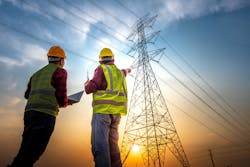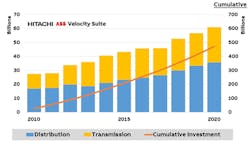North America’s electric grid faces rising resiliency challenges brought on by climate change and a shift away from fossil fuels toward renewable generation.
Recent events have demonstrated that the U.S. requires additional transmission infrastructure to integrate new renewable energy sources, accommodate plant retirements, better match production and demand centers, and facilitate increased interregional exchanges of electricity when power systems are under stress.
Washington is considering substantial investments in bridges, roads, airports, internet bandwidth, and other critical parts of our infrastructure. As citizens, we welcome that federal initiative. We also see calls for significant investment in the modernization of the electric transmission and distribution system to meet decarbonization goals and improve grid resiliency.
Transmission lines are the critical link connecting electric supply with demand. Like interstate highways used to transport commercial goods across the continent, transmission lines are a life-sustaining resource. That resource is being stressed by more frequent and more extreme weather, almost certainly due to climate change, and is not currently aligned with the locations of our emerging sources of renewable energy.
Extreme Weather Stressing the Grid
During August 2020, soaring electric demand during a historic heatwave forced the California Independent System Operator (CAISO) to initiate rolling blackouts that turned off the air conditioners for an estimated 800,000 people. Six months later, a deep freeze in Texas nearly brought down the entire electric system, resulting in the deaths of over 100 people. Months later, as North America entered the summer of 2021, historic wildfires and heat waves cooked equipment and drove a spike in demand for electricity, forcing grid operators to call power emergencies in multiple regions.
As extreme weather events increase in frequency and intensity, the resiliency challenges to the grid are multiplying.
Diversifying Energy Generation Assets with a Focus on Renewables
Over the last decade, asset owners retired nearly 200,000 megawatts (MW) of North American electric generating capacity. Much of the retired capacity burned coal, but aging gas-fired generation and uneconomic nuclear generators have been shuttered as well. Retirement announcements ebb and flow, but they are not done yet. Over the next 10 years, we expect an additional 100,000 MW of generating capacity to be retired across North America.
Construction of renewable generation, first wind and more recently solar, has surged as prices fell, regulatory mandates took effect, and businesses and consumers voiced their desire for more emission-free electricity. Data tracked by the Hitachi ABB Power Grids Velocity Suite showed U.S. utilities added about 142,000 MW of renewable generation between 2010 and 2020 (see chart).
More emission-free energy is on the way, supported by extensions in the U.S. of federal tax credits for onshore wind power and solar generation and the creation of a new one to support offshore wind generation. U.S. President Joe Biden wants to have a carbon-free electricity sector by 2035 and a net-zero carbon economy by 2050. As a step toward realizing those ambitions, the White House announced a goal of constructing 30,000 MW of offshore wind by 2030.
Hitachi ABB Power Grids has broad and deep experience in offshore wind energy projects, having installed high voltage direct current (HVDC) lines connecting several large offshore windfarms to consumers and businesses in Europe. The world’s largest offshore wind project, the 3,600-MW Dogger Bank Wind Farm, will use its HVDC Light® technology, which has the industry’s smallest footprint and lowest line losses, to efficiently transmit bulk power to millions of U.K. consumers.
T&D Spending Enables Decarbonization
Utilities across the U.S. and North America have also been spending heavily to construct new transmission and distribution (T&D) projects. U.S. utilities have invested a total of about $470 billion on new infrastructure between 2010 and 2020 (see chart), mainly to bring renewable generation, often sited in remote areas, to homes and businesses located in load centers.
That spending level, as high as it may seem, is almost certainly not enough. The energy emergencies of the last few years have shown that greater interregional exchanges of power could be a valuable tool to keep the lights on. Unfortunately, many large interstate transmission projects are sometimes delayed or denied by state regulators.
For example, as a standalone electricity market, the Electric Reliability Council of Texas (ERCOT) has limited ability to import or export power to the adjacent Eastern and Western interconnections. Greater ability to transmit power could have helped bring much-needed power to Texas and other regions impacted by local power plants going offline due to unexpectedly cold temperatures this past February.
The 500-kilovolt, 224-mile Great Northern Transmission Line, which uses advanced series capacitors supplied by Hitachi ABB Power Grids, is bringing low-cost, emission-free hydropower from Manitoba to Minnesota. This project is critical for Minnesota Power to fulfill its carbon-reduction plans.
Additional opportunities exist for Canadian hydropower to be imported into the U.S. to help address carbon reduction goals with the potential to send wind and solar power north to create a more flexible, continent-wide power market.
Canada is also modernizing its transmission network, in large part to facilitate greater inter-regional and international exchanges of power. This is part of a global trend which appears to be accelerating. We’ve seen similar successful projects in Europe, such as the NordLink Connector, which offers a model of how to create a larger, more flexible, and ultimately more resilient region-wide electricity sharing structure as part of a decarbonization agenda.
Decarbonization, Grid Resiliency Requires Greater Investment in Transmission
“After the Texas transmission debacle this winter, no one can doubt the need to invest in our electric grid," White House climate adviser Gina McCarthy said in a statement this spring.[1] Others, including Energy Secretary Jennifer Granholm, echoed McCarthy’s sentiment.
Decarbonizing electric generation only succeeds if there is a robust electric transmission network to carry that low- or no-carbon electricity from remote sites where it is generated to businesses and homes.
As the plans for upgrading North American infrastructure get closer to becoming a reality, federal officials in Washington and Ottawa—as well as state and provincial regulatory officials across the continent—must redouble their efforts to ensure that necessary investments aremade in each nation’s transmission system.
[1] Rachel Frazin and Zack Budryk, “Biden administration announces $8.25B in loans to boost power grid,” THE HILL (April 27, 2021).
Sponsored by:
Hitachi ABB Power Grids



